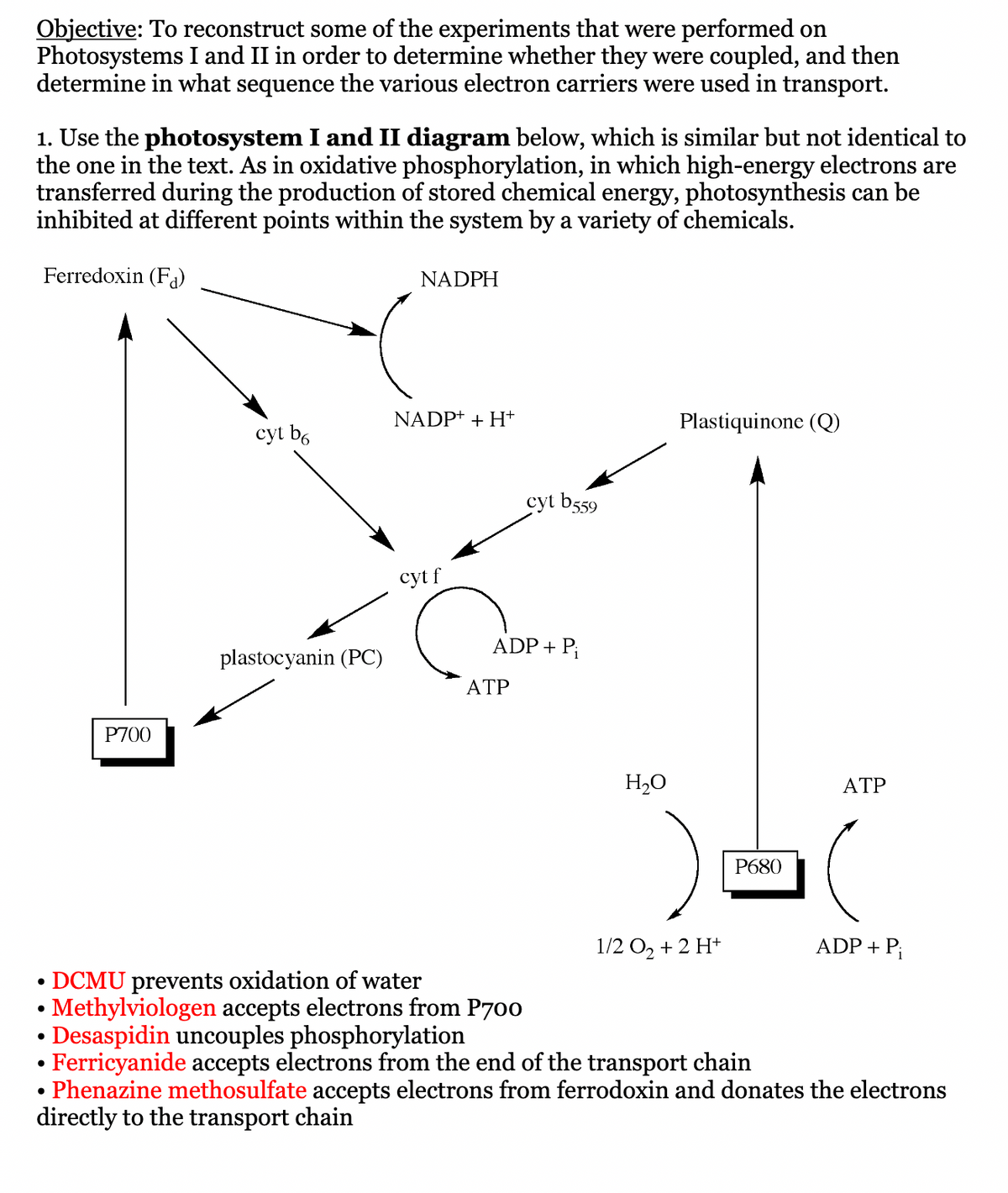Which photosystem (I, II, both or neither) is disrupted by each of the inhibitors? Explain how you arrived at your answer. DCMU Methylviologen Desaspidin Ferricyanide Phenazine methosulfate
Which photosystem (I, II, both or neither) is disrupted by each of the inhibitors? Explain how you arrived at your answer. DCMU Methylviologen Desaspidin Ferricyanide Phenazine methosulfate
Biochemistry
9th Edition
ISBN:9781319114671
Author:Lubert Stryer, Jeremy M. Berg, John L. Tymoczko, Gregory J. Gatto Jr.
Publisher:Lubert Stryer, Jeremy M. Berg, John L. Tymoczko, Gregory J. Gatto Jr.
Chapter1: Biochemistry: An Evolving Science
Section: Chapter Questions
Problem 1P
Related questions
Question
Which photosystem (I, II, both or neither) is disrupted by each of the inhibitors?
Explain how you arrived at your answer.
DCMU
Methylviologen
Desaspidin
Ferricyanide
Phenazine methosulfate
Explain how you arrived at your answer.
DCMU
Methylviologen
Desaspidin
Ferricyanide
Phenazine methosulfate

Transcribed Image Text:Objective: To reconstruct some of the experiments that were performed on
Photosystems I and II in order to determine whether they were coupled, and then
determine in what sequence the various electron carriers were used in transport.
1. Use the photosystem I and II diagram below, which is similar but not identical to
the one in the text. As in oxidative phosphorylation, in which high-energy electrons are
transferred during the production of stored chemical energy, photosynthesis can be
inhibited at different points within the system by a variety of chemicals.
Ferredoxin (F)
P700
cyt b6
●
plastocyanin (PC)
NADPH
NADP+ + H+
cyt f
ADP + Pi
ATP
cyt b559
DCMU prevents oxidation of water
Methylviologen accepts electrons from P700
H₂O
Plastiquinone (Q)
1/2 O₂ + 2 H+
P680
• Desaspidin uncouples phosphorylation
Ferricyanide accepts electrons from the end of the transport chain
ATP
ADP + P₁
Phenazine methosulfate accepts electrons from ferrodoxin and donates the electrons
directly to the transport chain
Expert Solution
This question has been solved!
Explore an expertly crafted, step-by-step solution for a thorough understanding of key concepts.
This is a popular solution!
Trending now
This is a popular solution!
Step by step
Solved in 3 steps

Recommended textbooks for you

Biochemistry
Biochemistry
ISBN:
9781319114671
Author:
Lubert Stryer, Jeremy M. Berg, John L. Tymoczko, Gregory J. Gatto Jr.
Publisher:
W. H. Freeman

Lehninger Principles of Biochemistry
Biochemistry
ISBN:
9781464126116
Author:
David L. Nelson, Michael M. Cox
Publisher:
W. H. Freeman

Fundamentals of Biochemistry: Life at the Molecul…
Biochemistry
ISBN:
9781118918401
Author:
Donald Voet, Judith G. Voet, Charlotte W. Pratt
Publisher:
WILEY

Biochemistry
Biochemistry
ISBN:
9781319114671
Author:
Lubert Stryer, Jeremy M. Berg, John L. Tymoczko, Gregory J. Gatto Jr.
Publisher:
W. H. Freeman

Lehninger Principles of Biochemistry
Biochemistry
ISBN:
9781464126116
Author:
David L. Nelson, Michael M. Cox
Publisher:
W. H. Freeman

Fundamentals of Biochemistry: Life at the Molecul…
Biochemistry
ISBN:
9781118918401
Author:
Donald Voet, Judith G. Voet, Charlotte W. Pratt
Publisher:
WILEY

Biochemistry
Biochemistry
ISBN:
9781305961135
Author:
Mary K. Campbell, Shawn O. Farrell, Owen M. McDougal
Publisher:
Cengage Learning

Biochemistry
Biochemistry
ISBN:
9781305577206
Author:
Reginald H. Garrett, Charles M. Grisham
Publisher:
Cengage Learning

Fundamentals of General, Organic, and Biological …
Biochemistry
ISBN:
9780134015187
Author:
John E. McMurry, David S. Ballantine, Carl A. Hoeger, Virginia E. Peterson
Publisher:
PEARSON